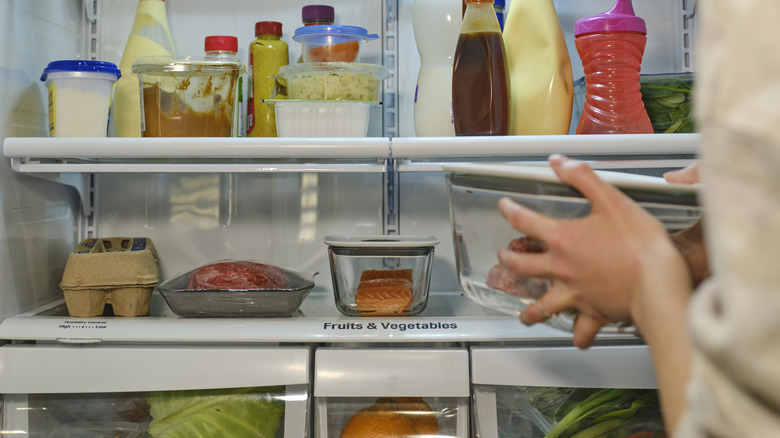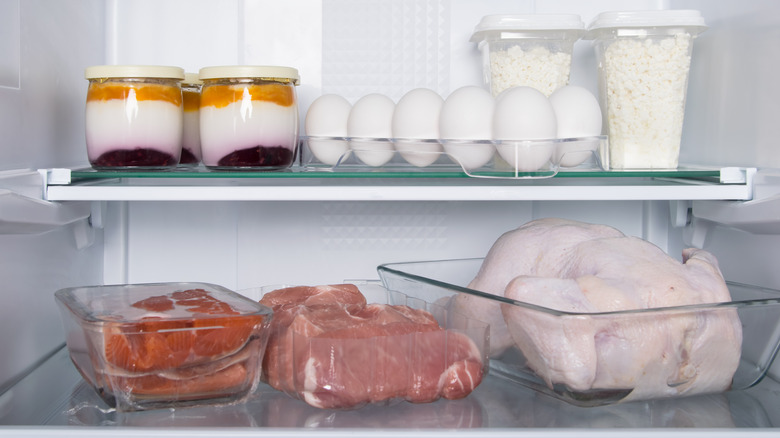The Refrigerator Organization Strategy To Keep Raw Meat Juices At Bay
While social media trends may have shifted our food storage focus to Instagram-worthy aesthetics, properly organizing the refrigerator is essential for preventing the spread of harmful food poisoning bacteria from different items you have on hand. Knowing where to store raw versus deli meat in relation to your fresh produce, dairy products, and cooked leftovers will help avoid cross-contamination, minimizing the risk of illnesses like salmonella or E.coli. Proper storage can also go a long way in mitigating messy cleanups if something in your fridge leaks.
Unlike smaller refrigerators you'll find in Europe, where groceries are often shopped for daily, American versions can be cavernous appliances storing a week's worth of meals plus after-school snacks. Even though meal prep can be a tremendous timesaver, stocking the fridge increases the chances of getting sick when a shrink-wrapped meat tray leaks or you bust a hole in a plastic storage bag, spilling meat-soaked marinade all over the refrigerator shelf.
You can keep everyone safer by storing smarter. According to the Academy of Nutrition and Dietetics, packages of raw meat, including poultry and fish, should be stored on the lowest rack in the fridge, one of the coldest locations. In the event of a leak, meat juices won't spill onto ready-to-eat foods like salads, which won't be cooked and may not be adequately washed afterward.
Dedicate space to each food group
According to the logic, leftovers should be kept on the highest shelf in the fridge, safe from any unintended accidents. Raw produce, deli meat, and cheeses should be placed in separate bins. Avoid mixing fruit and vegetables in the same bin since some fruit emits ethylene gas which can spoil veggies prematurely. Ready-to-eat precut fruit and vegetables like carrot sticks or apple slices should be stored in a container with a lid.
Refrigerators should be set below 40 degrees, keeping in mind that opening the door or storing hot foods will raise the internal temperature temporarily. Despite foodborne bacteria being killed when cooked to a specific temperature, consuming contaminated foods in the danger zone between 40 and 140 degrees Fahrenheit, including meat, leftovers, and raw produce, can send your unsuspecting dinner guests home with more than a doggie bag (fever, diarrhea, and abdominal cramps or worse), especially older adults, young children, and those with chronic conditions.
How to store meat in the refrigerator
When it comes to storing meat properly, it's safer and more eco-friendly to avoid placing raw meat in disposable plastic packaging or bags that can easily tear directly in the fridge. Instead, transfer the meat to a reusable, sturdy, BPA-free plastic or glass container with high sides. Whether you're keeping the meat in its original supermarket packaging or wet marinating some chicken, if the plastic breaks, a high-walled container will trap the leak. And be sure to cover any raw meat with a lid or plastic wrap to prevent germs from splashing onto other foods.
And keep in mind that raw meat and fish should be consumed within a few days of purchasing or stored in the freezer. Discard anything that smells funky, looks discolored, or develops a slimy surface, and remember freezing the meat does not reset the freshness clock. Cook defrosted meat within two days.



